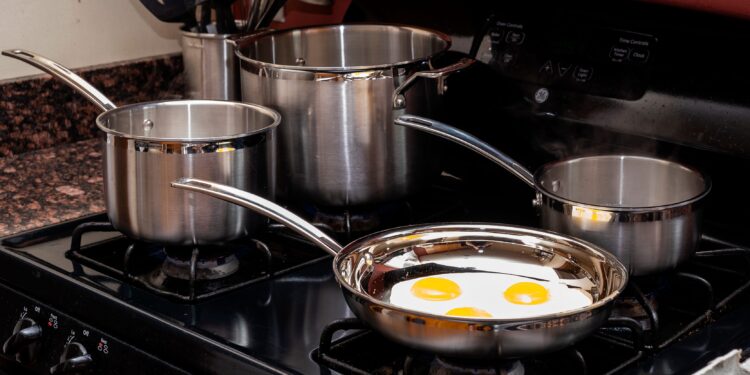The kitchen is one of the essential rooms in any home. It’s where you cook your food, entertain guests, and spend time with family. So it’s vital to have the right tools for the job! Do you want pots that are lightweight or heavy-duty? Do you need something easy to clean? Is weight an issue because of injuries or age? These are all things worth considering before making a purchase. Do you know what to look for in a kitchenware set? Again, it’s essential to have the right tools for the job, so it pays off to invest in quality. Many different sets are available, including cutlery sets and cooking utensils, so it can be hard to know which one is best for your needs.
This post will help you figure out what type of kitchenware set you need and how much money to budget when shopping around!
Budgeting for kitchenware sets:
- One of the most important factors before buying kitchenware sets is to set a budget that you are comfortable with. You can find sets that range from about $30 to $300, so pick one within your financial means. If you want everything in the world, consider whether or not it’s worth it to spend the extra money.
- While some people prefer buying cheap items from the local dollar store, it’s not often that you will be able to find high-quality items there. A better option might be to shop around for discount kitchenware sets or wait for sales so you can get what you need without spending too much money. If you want the basics, it’s worth checking thrift shops and yard sales to see if you can find bargains on clean, gently used pieces.
- Consider the material of each instrument- ceramic, stainless steel, or glass. Think about the types of dishes you prepare and serve. For example, if you often use heavy pots or pans for boiling or frying, stainless steel would be a good choice for your cookware set. Material matters as you will constantly be using them. You will not want to use them for complex or heavy food preparation.
- The correct utensils: Some kitchen accessories are designed with specific uses in mind, so it’s important to know what each is for before you start cooking. This way, everyone can have their utensil, and you won’t have to worry about anyone accidentally grabbing the wrong one! A good set should have at least one of each cooking utensil.
- Family members and cooking: Think about what you need your potential purchase to do. What types of foods will you prepare most frequently? How many people will you usually cook for? If more than two of you are, make sure the set is large enough to accommodate everyone; otherwise, it could get frustrating having to hand off one dish but not having enough utensils to cover you up.
-
- Kitchenware sets: utensils and kitchenware can be made up of all or some tools; It’s often best to start with just the basics and then buy more specialized items later. For example, an onion chopper may not be necessary if you already have knives to cut onions into small pieces. You know your lifestyle and cooking habits best so take the time to think about what tools you’ll need.
- Determine if you need a set or individual pieces: Some locations include both cookware and utensils, while others focus on one or the other. For example, a group of cooking utensils may come with a ladle, turner, slotted spoon, and spaghetti server. A cutlery set might contain an 8-inch chef’s knife and a paring knife.
- If you need a set of utensils, then you can save money by purchasing them separately. However, if you don’t already own cookware and would like to buy a complete set, buying the pieces together as a package is usually more affordable than purchasing each item individually.
If you like to bake pies, look for a baking dish in the set. If you’d prefer to do lots of stir-frying, the set should include a wok and a frying pan.
look for a pot that’s big enough to cook the dish in. If you like to roast veggies, choose a set with a roasting pan.

Look for quality materials: If you want your kitchenware set to last, it’s essential to look for quality materials. Stainless steel is highly versatile because you can use it on induction cooktops and in ovens, as well as on the stovetop. However, stainless steel tends to tarnish quickly, so avoid sets with a mirror finish unless you enjoy polishing your utensils. Anodized aluminium has a non-stick surface and is easy to care for, but it tends to be more expensive than stainless steel. Enamelled cast iron is another good choice because it heats evenly and can go from the stovetop to the oven. Look for enamelled cast iron with a porcelain exterior because this type of material won’t react with acidic foods. If you can’t afford to buy an entire set in a kind of material, choose the utensils that are most important to you and pick a matching pan or two.
-
- Nonstick vs. regular: When choosing between non-stick and regular pans, your primary concern should be health. Nonstick pans are treated with chemicals often heated to high temperatures during use, leading to . On the other hand, some studies show that Teflon-coated pans may release small particles into the food that may be harmful if ingested frequently. If you cook regularly and need nonstick pans for convenience, it’s best to purchase them instead.
- Consider how easy it is to clean each kitchen piece- some are easier to clean than others. Also, consider if one type of material might mark or stain easier and what that could mean for the look of the items. Also, consider how much time you have to clean the items. If you don’t have a dishwasher or prefer to hand wash dishes, choose easy-to-wash options. Prefer and select nonstick brands and plastic coated utensils, while others prefer to buy a complete set of high-quality cookware and select kitchen tools individually. For those who don’t want to spend a lot of time cleaning, buy plastic utensils as they tend quickly.
Conclusion
Are you a great cook who loves to spend hours in the kitchen preparing healthy meals every day? Or are you less active cooking-wise? Do you prefer to spend more or less time in the kitchen? If the utensils are prone to everyday cooking, you might want to invest in long durable instruments, but if it’s occasional cooking paraphernalia, you might want to cut down the number of items on the list. Happy cooking!






